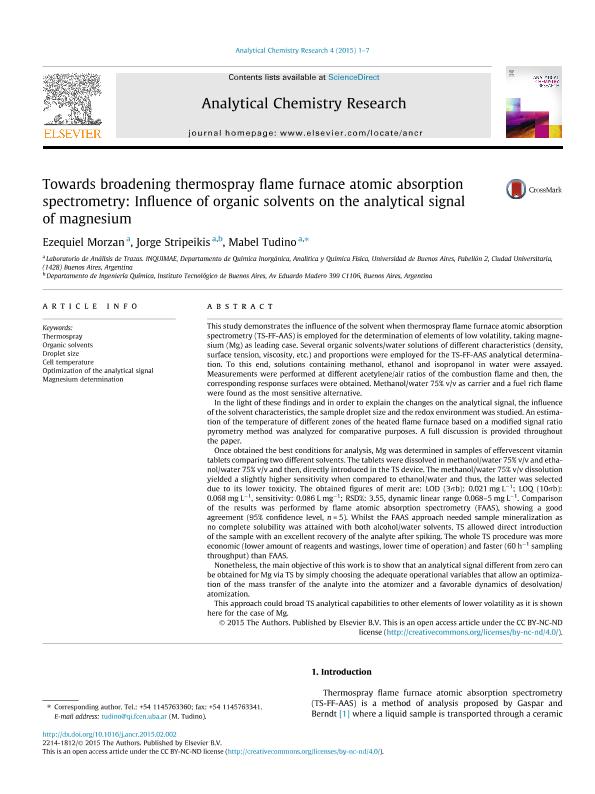Mostrar el registro sencillo del ítem
dc.contributor.author
Morzan, Ezequiel Martin

dc.contributor.author
Stripeikis, Jorge Daniel

dc.contributor.author
Tudino, Mabel Beatriz

dc.date.available
2018-09-10T19:34:28Z
dc.date.issued
2015-06
dc.identifier.citation
Morzan, Ezequiel Martin; Stripeikis, Jorge Daniel; Tudino, Mabel Beatriz; Towards broadening thermospray flame furnace atomic absorption spectrometry: Influence of organic solvents on the analytical signal of magnesium; Elsevier; Analytical Chemistry Research; 4; 6-2015; 1-7
dc.identifier.issn
2214-1812
dc.identifier.uri
http://hdl.handle.net/11336/58964
dc.description.abstract
This study demonstrates the influence of the solvent when thermospray flame furnace atomic absorption spectrometry (TS-FF-AAS) is employed for the determination of elements of low volatility, taking magnesium (Mg) as leading case. Several organic solvents/water solutions of different characteristics (density, surface tension, viscosity, etc.) and proportions were employed for the TS-FF-AAS analytical determination. To this end, solutions containing methanol, ethanol and isopropanol in water were assayed. Measurements were performed at different acetylene/air ratios of the combustion flame and then, the corresponding response surfaces were obtained. Methanol/water 75% v/v as carrier and a fuel rich flame were found as the most sensitive alternative.In the light of these findings and in order to explain the changes on the analytical signal, the influence of the solvent characteristics, the sample droplet size and the redox environment was studied. An estimation of the temperature of different zones of the heated flame furnace based on a modified signal ratio pyrometry method was analyzed for comparative purposes. A full discussion is provided throughout the paper.Once obtained the best conditions for analysis, Mg was determined in samples of effervescent vitamin tablets comparing two different solvents. The tablets were dissolved in methanol/water 75% v/v and ethanol/water 75% v/v and then, directly introduced in the TS device. The methanol/water 75% v/v dissolution yielded a slightly higher sensitivity when compared to ethanol/water and thus, the latter was selected due to its lower toxicity. The obtained figures of merit are: LOD (3σb): 0.021mgL-1; LOQ (10σb): 0.068mgL-1, sensitivity: 0.086Lmg-1; RSD%: 3.55, dynamic linear range 0.068-5mgL-1. Comparison of the results was performed by flame atomic absorption spectrometry (FAAS), showing a good agreement (95% confidence level, n=5). Whilst the FAAS approach needed sample mineralization as no complete solubility was attained with both alcohol/water solvents, TS allowed direct introduction of the sample with an excellent recovery of the analyte after spiking. The whole TS procedure was more economic (lower amount of reagents and wastings, lower time of operation) and faster (60h-1 sampling throughput) than FAAS.Nonetheless, the main objective of this work is to show that an analytical signal different from zero can be obtained for Mg via TS by simply choosing the adequate operational variables that allow an optimization of the mass transfer of the analyte into the atomizer and a favorable dynamics of desolvation/atomization.This approach could broad TS analytical capabilities to other elements of lower volatility as it is shown here for the case of Mg.
dc.format
application/pdf
dc.language.iso
eng
dc.publisher
Elsevier
dc.rights
info:eu-repo/semantics/openAccess
dc.rights.uri
https://creativecommons.org/licenses/by-nc-sa/2.5/ar/
dc.subject
Cell Temperature
dc.subject
Droplet Size
dc.subject
Magnesium Determination
dc.subject
Optimization Of the Analytical Signal
dc.subject
Organic Solvents
dc.subject
Thermospray
dc.subject.classification
Otras Ciencias Químicas

dc.subject.classification
Ciencias Químicas

dc.subject.classification
CIENCIAS NATURALES Y EXACTAS

dc.title
Towards broadening thermospray flame furnace atomic absorption spectrometry: Influence of organic solvents on the analytical signal of magnesium
dc.type
info:eu-repo/semantics/article
dc.type
info:ar-repo/semantics/artículo
dc.type
info:eu-repo/semantics/publishedVersion
dc.date.updated
2018-09-04T19:05:07Z
dc.journal.volume
4
dc.journal.pagination
1-7
dc.journal.pais
Reino Unido

dc.description.fil
Fil: Morzan, Ezequiel Martin. Consejo Nacional de Investigaciones Científicas y Técnicas. Oficina de Coordinación Administrativa Ciudad Universitaria. Instituto de Química, Física de los Materiales, Medioambiente y Energía. Universidad de Buenos Aires. Facultad de Ciencias Exactas y Naturales. Instituto de Química, Física de los Materiales, Medioambiente y Energía; Argentina
dc.description.fil
Fil: Stripeikis, Jorge Daniel. Consejo Nacional de Investigaciones Científicas y Técnicas. Oficina de Coordinación Administrativa Ciudad Universitaria. Instituto de Química, Física de los Materiales, Medioambiente y Energía. Universidad de Buenos Aires. Facultad de Ciencias Exactas y Naturales. Instituto de Química, Física de los Materiales, Medioambiente y Energía; Argentina. Instituto Tecnológico de Buenos Aires. Departamento de Ingeniería Química; Argentina
dc.description.fil
Fil: Tudino, Mabel Beatriz. Consejo Nacional de Investigaciones Científicas y Técnicas. Oficina de Coordinación Administrativa Ciudad Universitaria. Instituto de Química, Física de los Materiales, Medioambiente y Energía. Universidad de Buenos Aires. Facultad de Ciencias Exactas y Naturales. Instituto de Química, Física de los Materiales, Medioambiente y Energía; Argentina
dc.journal.title
Analytical Chemistry Research
dc.relation.alternativeid
info:eu-repo/semantics/altIdentifier/doi/https://dx.doi.org/10.1016/j.ancr.2015.02.002
dc.relation.alternativeid
info:eu-repo/semantics/altIdentifier/url/https://www.sciencedirect.com/science/article/pii/S221418121500004X
Archivos asociados
